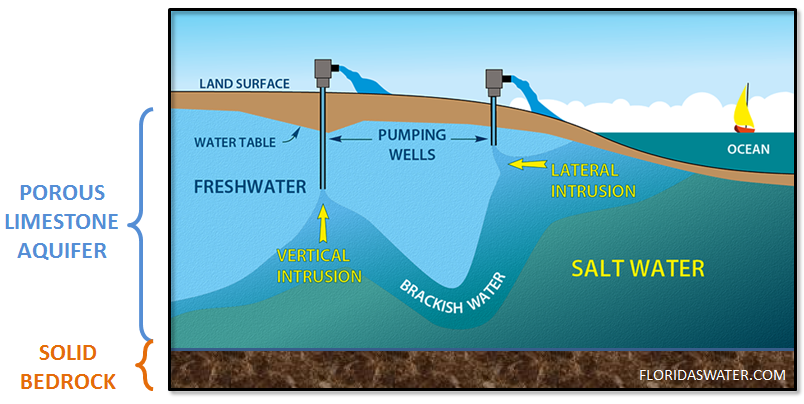
A report titled Climate Change AND Sea-Level Rise IN Florida notes the hellish calamity that will affect Florida's urban populations, economy, ecosystems and coasts.
What we know
Florida's Biscayne Aquifer, the principal water supply to southeastern Florida and the Florida Keys, is recharged by rainfall and the freshwater Everglades. Surficial coastal aquifers are already experiencing saltwater intrusion. Rising sea level will increase the hydraulic backpressure on coastal aquifers, reduce groundwater flow toward the ocean, and cause the saltwater front to move inland, thus threatening to contaminate water-supply wells in coastal areas with seawater. In the low-lying southernmost Everglades, sea-level rise will cause brackish waters to encroach fartherWhat is Probable
northward.
The Pensacola Bay and St. Johns River watersheds and southern Florida from Palm Beach to Miami, the Florida Keys, Naples, and Fort Myers are especially vulnerable to saltwater intrusion into municipal freshwater supplies as sea levels rise (Dausman and Langevin, 2005; Freed et al., 2005; Murley et al., 2008).
The Comprehensive Everglades Restoration Plan's main purpose is to increase freshwater flow to the southern Everglades. This will help offset the effect of sea-level rise and help preserve Everglades ecologies and southern Florida's water supply (South Florida Water Management District, 2009a). The South Florida Water Management District already spends millions of dollars per year to prevent Miami's Biscayne Aquifer from becoming brackish (Miller et al., 1989). Rising sea level will cause groundwater near the coast to become more saline and groundwater levels to increase.
As sea level continues to rise, these effects will increase the extent of saltwater intrusion especially during periods of drought and the dry winter/spring
season (Heimlich et al., 2009).
Sea-level rise of 15 centimeters (about 6 inches) and more will require implementing adaptation strategies such as water conservation, wastewater reuse, recovery and recharge, stormwater storage, alternative water supplies including desalination, and other advanced water-management strategies in order to assure adequate water supplies (Heimlich et al., 2009).
If the saline waterfront moves far enough north, it could contaminate the headwaters of the Biscayne Aquifer and southern Miami-Dade County's water supply Intergovernmental Panel on Climate Change, 2007; Heimlich et al., 2009; Karl et al.,
2009).
This contamination would increase the salt content of leakage into sewer collection systems and complicate wastewater treatment operations. Water and wastewater treatment facilities that are located at low elevations in coastal regions may be subject to more frequent flooding during spring tides and storm surges (Bloetscher et al., 2009).
Interior regional hydrologic systems of Florida should not be significantly affected (Trimble et al., 1998).
Municipal sewer systems will have to be tightened to significantly reduce groundwater seepage in order to protect wastewater treatment operations (Bloetscher et al., 2009).



Comment: The area is attempting to support more population than the aquifer can supply. Larger earth changes are also threatening the area.